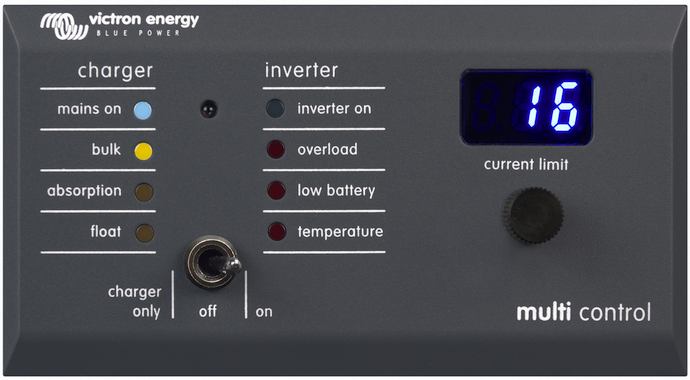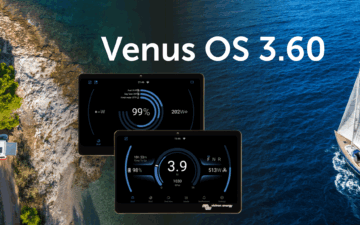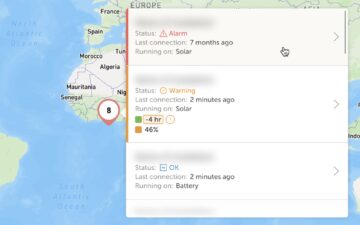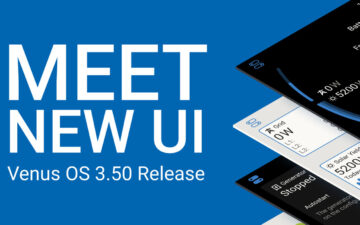
Good news – a number of the MultiPlus, MultiGrid and Quattro Inverter/Chargers now have lower minimum input current limits for PowerAssist, particular the 120V American market models along with some of the 230V models.
A quick recap on PowerAssist
PowerAssist is the ability of Victron inverter/chargers to supply more power than is actually available from an AC supply – be that shore power for a boat in a marina, power hook-up for a motorhome, caravan, trailer tent or indeed any home, even a holiday cabin with only solar, batteries and an AC generator electricity supply.
The power available from such AC supplies is the voltage times the current rating of the supply. For example a UK marina bollard is 230V and usually rated at 16A. That gives us 3.68kW of available power – but what if you want to keep that 2kW fan heater running and boil a 2.5kW kettle at the same time, requiring 4.5kW combined?
If you tried to do that without PowerAssist you would trip the supply, but with PowerAssist your boat batteries supply DC power to the inverter side and an instantaneous fast transfer switch adds this DC to AC converted power to the marina AC shore power. Now you have this combined AC power total to run that heater and kettle, for the short time it takes to boil the kettle. Once boiled the kettle switches off, the inverter stops inverting and goes back to doing nothing – and the shore supply continues to run your AC fan heater as before.
With just the fan heater running the available remaining AC power is 1.18kW (3.68kW shore supply – 2.0kW fan heater) which can be used for DC charging of your batteries and/or any small AC consumers up to that remaining 1.18kW of available shore power. Anything over that and PowerAssist can kick back in again as you choose, up to the specifications of the inverter side.
If you don’t want to use any PowerAssist from your batteries, switch to charger only and now the AC shore supply will still be on and the inverter will be off, leaving that 3.68kW AC shore supply available for DC charging and AC power for any small AC consumers, such as laptops, TVs, a toaster etc.
If you then set the current to zero the charger will be off, the AC supply will pass through and the inverter can’t kick in – handy if away from the boat and shore power fails, as then your batteries can’t be drained by the inverter whilst away. There’s even more sophistication and control if using a Color Control GX or Venus GX, but that is outside the scope of this blog.
Why these lower minimum current limits matter
Lower minimum input current limits means that PowerAssist is available from a lower current set-point than was previously available. Here’s an example:
Previously the 120V Quattro 12/5000/120-2×100 model had a current limit of 19.1A, but now due to a new firmware release this has been reduced to 13.0A. The maximum current supply that a standard USA outlet gives is 15A, so there was no PowerAssist as the minimum set-point was 19.1A. In other words now you can use the PowerAssist feature from a 13.0A set-point with that model Quattro – compared to not being able to use it at all previously!
Firmware upgrade required
To achieve these improvements you will need a firmware version equal to or greater than #423 – available via Victron Professional:
https://professional.victronenergy.com/downloads/firmware
Warning
As the required new firmware wipes all previous settings (back to defaults) during an update, this process is for those with expert Victron knowledge – not for end users. If in any doubt consult your Victron Energy dealer.
Firmware update instructions: Updating VE.Bus firmware, using VEFlash
Minimum shore current limits for different models
The minimum shore current limits are listed in a spreadsheet, available via Victron Professional. If you are not already registered for Victron Professional please do so at:
https://professional.victronenergy.com
Then locate the VE.Bus (Multis, Inverters and Quattros) folder and the Excel spreadsheet at:
https://professional.victronenergy.com/downloads/firmware
Conclusion
These MultiPlus, MultiGrid & Quattro Inverter/Chargers with their improved minimum current limits will clearly be of value to many, particularly those with an American 120V/15A supply at their camping ground or dock.
On that note, we’d like to give a shout out to Victron aficionados Chris Dunphy & Cherie Ve Ard – in prompting/reminding us to introduce these changes for the American market. Here’s their take on boosting electrons, which even though it is dated now shows just how far Victron have been ahead of the curve over the years. You can learn more about their tech and fascinating adventures (be they by land or sea) at: http://www.technomadia.com
John Rushworth














